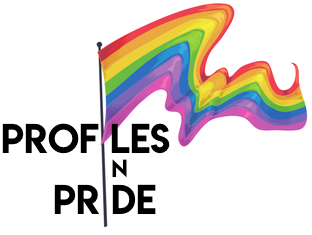When Kai Hazelwood was growing up, she was busy training to be a dancer and wasn’t interested in dating. She didn’t give any thought to her sexuality…until a beautiful girl approached her in early high school.
It took a few years, but Hazelwood eventually realized she was indeed attracted to women, but not exclusively. She came out as bi to her family with little fanfare, and she found that she was much happier living openly and authentically as bi, even when dating cis men. Hazelwood went on to have a successful dance career, training and performing with ballet companies all around the world.
Like most bi people, Hazelwood has had to come out over and over again in her life, and she eventually became involved in bi activism. She began infusing her dance performances with elements of bisexual visibility. After performing an original dance piece at a small bi festival over five years ago that told the story of her bisexuality, Hazelwood was touched by how it resonated with people who often felt invisible.
Hazelwood has also become passionate about spreading the word that bisexuality isn’t about being interested in cis men and cis women; she points to activists who believe that bisexuality simply means you can be attracted to your gender or other genders. This makes it trans- and nonbinary-inclusive, she says.
Hazelwood ended up founding Good Trouble Makers, a collective of bi+ movement artists. And on September 14, in honor of Bi Visibility Month, Hazelwood is producing the inaugural Unicorn pARTy in Los Angeles in partnership with several bi organizations. At this 21+ up event, Good Trouble Makers will perform inVISIBLE, a new work by Hazelwood featuring dance and movement set against recordings she made of real bi+ people telling their stories. Hazelwood, now 34, is excited to create an evening full of art, dance, music and revelry celebrating love for more than one gender.
In addition the performance by Good Trouble Makers, the event will feature a musical lineup LA-based bi+ artists and bands, in addition to a queer craft fair. While the event centers bi+ people, Hazelwood says the event is for anyone and everyone who wants to come celebrate the community.
This is Hazelwood’s story of claiming her bi identity, learning how to weave bi visibility into her dance career, and putting on the first ever Unicorn pARTy.
Profiles in Pride: What was your journey to realizing you were bisexual and coming out?
Kai Hazelwood: Growing up, I sort of identified as nothing; I wasn’t in touch with that part of myself until the end of high school. But in the beginning of high school, a gorgeous woman at my school walked up to me and said, “Yeah, this is going to happen, you and me.” I said, “Uh, I don’t identify as anything, I don’t date anyone, never have, not interested in starting, I don’t know what you’re talking about.”
Fast forward a year and a half, and she was right! As far as coming out, though, mine was pretty easy and fun and joyous because she sort of saw this coming and I really didn’t. I didn’t have any resistance to it. I just honestly at that point I was focused on being an artist and training that dating was not on my radar at all. So Jessica, wherever you are, thanks for that!
PIP: Did you come out to your family at that time too?
KH: I did, and my mom and I have differing memories about how that went. I feel like I was very clear, and my mom sort of thought I was acknowledging that I was experimenting. Like many bi people do, I’ve come out dozens of times. I feel like at this point, I’m so out that there’s no way for people to be confused, but I’ve definitely come out a lot of times.
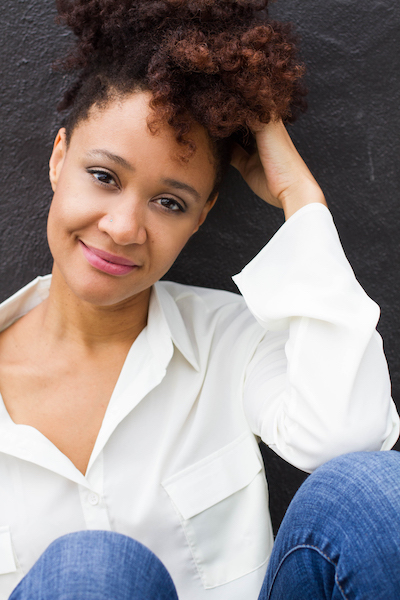
PIP: Did you identify as bi back then too?
KH: You know, I don’t know how I got attached to the term bi, but that is the term I started using in high school, and I can’t remember why or who introduced me to that word. But it’s the one that felt right and still does, so that’s still the identity I hold close to my heart in large part because of the large community that I’ve built around that identity.
PIP: Could you share your definition of bi? I know there’s been a lot of talk lately about shifting the definition of bi from it meaning attraction to cis men and cis women, to being potentially attracted to anyone.
KH: I love that question, because I usually sneak it in in every interview anyway because I think it’s important for me to clarify. Now I don’t even have to sneak it in, I can just tell you!
I identify as bi and I use that term to mean attracted to my own gender and genders that are different from mine. I see it as very trans, nonbinary, and genderqueer inclusive.
It’s the definition that I was introduced to through long-time bi activists that I was lucky enough to learn from and call my friends, like Ian Lawrence. He also pointed out that that is actually the definition of bi. This idea of being attracted to cisgender men and women was sort of an interpretation of the language, but if you actually go back and look at how the language was written, it’s quite open and meant to be inclusive of everyone.
So I feel less like it’s a new definition and more of reclaiming the spirit of what bi has always meant. Now of course I’m not the ultimate authority; that’s my own relationship to the term, but that’s how I think of it and use it.
PIP: I love that. I get asked this a lot — how do you feel that differs from pansexual? Do you get asked that a lot too?
KH: I do, I get asked that a lot, and I always say that I’ll never police the way anyone else identifies themselves, nor do I claim to understand all the nuances of people who identify as pan, because I don’t identify as pan.
To me, at least in the way that I express my bisexuality and use that term, I see that as a synonymous term, and we haven’t come up with something that makes everyone happy to include both of those terms. I often use bi+ to refer to anyone sort of in the middle of the spectrum. I recognize it’s a problematic term; it’s not perfect, but it’s the best one I’ve got right now. I’m totally open to learning new ones and better ones, but that’s what I’ve got at the moment.

KH: How did your career go from traditional dance to founding queer artist collective Good Trouble Makers?
KH: I grew up in the hardcore dance world; I was a ballerina for a very long time. I’m a highly trained dancer, and I’ve danced all over the world. Along the way, I was falling into being an activist. I think it was a little bit inevitable being a nearly 6-foot-tall black woman in a field like ballet.
By the time I got to college, my interests were more about “how can movement and dance be used as a tool to tell stories?” rather than exploring it as “what are the boundaries of physicality and how extreme and big and challenging can movement be?” In focusing in on telling stories, I started thinking about what kinds of stories I want to tell.
I’ve done work around race, and it also led me into this project that’s sort of been evolving over about five-and-a-half years now, telling stories of bi+ community members. It came about because I did a very short piece around five years ago in a bi pride art festival, on this tiny little outdoor stage and it wasn’t a fully fleshed out work. It resonated with a lot of people, and it made me curious about what telling our stories was like.
One of the things that really stuck with me was someone saying, “I’ve never heard my own stories on stage. I’ve never seen that reflected by my own people by any type of entertainment or performance medium.” I said, “That’s really interesting and sad. We should have that.” That’s sort of how this project was formed, inVISIBLE.
With Good Trouble Makers, I laugh when I get asked that question, because truly I never had an intention of building any type of dance company or formal dance entity — I don’t know why I’ve had very intense resistance to that idea my whole life, but I have. But I looked up a couple years ago and realized that after this very small couple-of-minutes piece I did five-and-a-half years ago, a lot of the people who were involved in this community then, I still work with now.
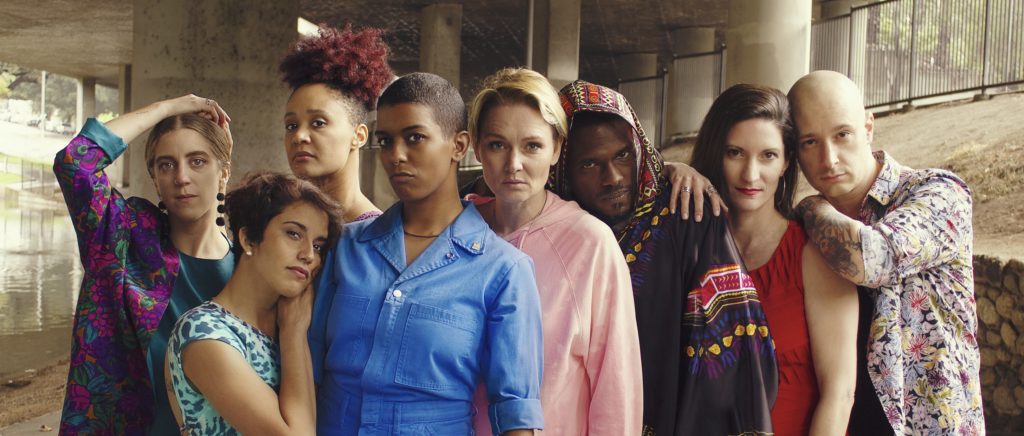
In the freelance market like we have in LA, to say I’ve been dancing with some of the same people going on for five years, it’s really unusual. All of a sudden there were nine of us, and then we needed to find some specifically people for a new project and put out an open call, and 34 people applied. We ended up interviewing 13 in person.
I had to acknowledge that this is a real thing that has sort of grown up around me. It needed to be formalized; we needed to think about what the values were, what the structure was going to be. That made me have to sit down and consider my own values as an artist.
What I really came down to at the core is I’m really interested in and passionate about centering the voices of queer/LGBTQ people and artists of color. To always work in a collaborative way, that’s very important to me, and to recognize that my collaborators are people from three different countries who identify in a variety of different ways as far as their gender, and the vast majority of whom are queer.
So it’s a very mixed collaborative, and I’m interested in these cross-cultural conversations and how those can get sensitive and sticky and messy, and the trust that’s built to be able to work in such a complex collaborative.
PIP: In the performances, do you tell the stories purely through dance? Or is there any speaking?
KH: We’ve done some pieces where it’s purely through dance, but the current iteration of inVISIBLE that’s premiering at Unicorn pARTy is actually a collaboration with real bi people telling real bi stories.
The first phase of the project was funded since I was named an artist in residence for the City of Los Angeles. I did a bunch of storytelling workshops and brought a lot of bi-identified people together and we recorded their stories.
Those stories are what you’re going to hear in the piece. Some of them are set directly to the story, some you listen to when there’s no movement. There’s some movement in silence, there’s some movement to music. But you’ll hear a whole bunch of actual recordings from bi+ people while we’re on stage.
PIP: That’s amazing. I’d love to learn more about the Unicorn pARTy — why did you create it?
KH: Unicorn pARTy is the party I wish I could have gone to when I was a baby queer marooned on hetero island and looking around going, “I don’t know where my people are, where do I go?!” It’s really just a celebration of queerness that centers people who identify somewhere on the middle of the spectrum, and within the night there’s the premiere of inVISIBLE, so there will be a dance and theater performance. There’s also a lineup of awesome bi musicians.
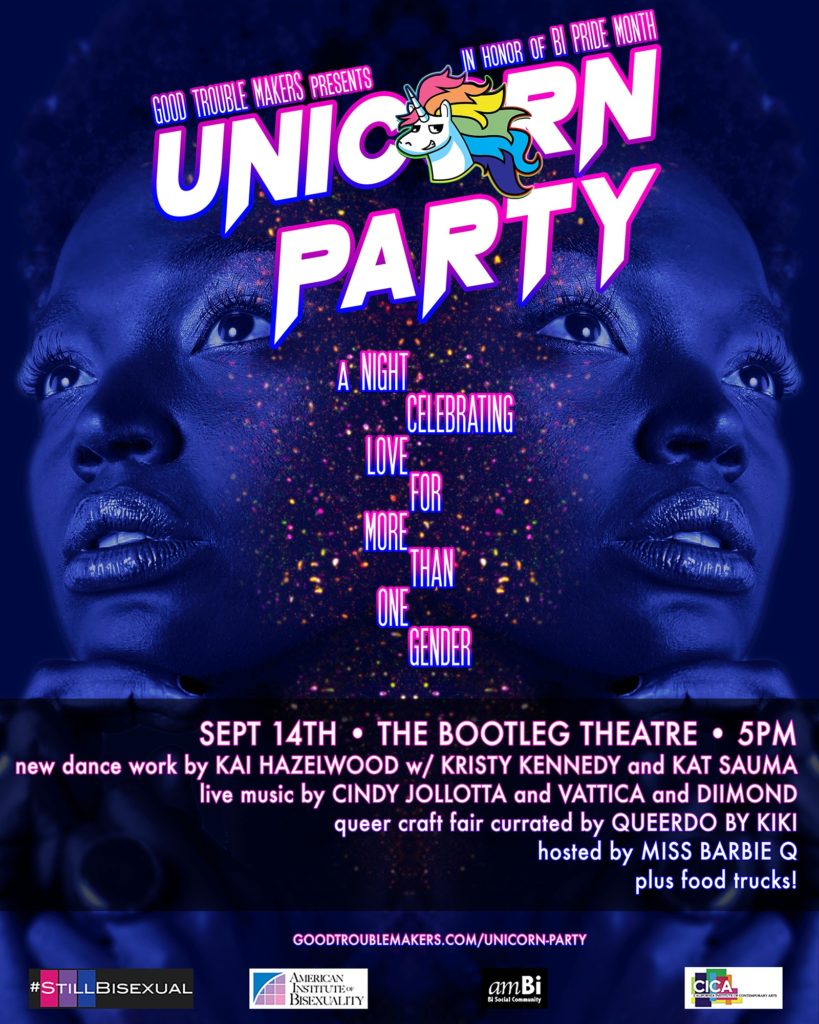
There’s VATTICA, and the frontman is a bi singer Alexander Millar, who also happens to be my partner. And Cindy Jollota, who’s a dear friend of mine and an incredible bi singer/songwriter who’s performing. There’s a queer craft market that’s curated by Queerdo by Kiki who’s also a Good Trouble Maker, and bi-identified. So it’s really centering bi folks, but queerness in general.
It’s going to be a wonderful, sparkling, rainbow, joyful celebration of community that for me really comes out of celebration and visibility as a political act.
Of course we need to march in the streets; of course policy change and political action is important. But I believe it’s also important to create joyful celebration as a community so that we can come together and be strong enough to fight the fights.
Also, I think there’s a sense of when we center particular communities, other people feel like they’re not welcome or not invited. So “if this is in honor of bi pride, then it’s only for bi people!” But that’s not how we feel about it. This is a celebration that’s centering and uplifting those stories, but everyone should hear those stories! Everyone should get to experience these artists, because they’re kickass artists. This is going to be a great sparkly magical evening for everyone. Come support the experience, art and stories by a community that maybe you’re not as familiar with, but it’s an open invitation.
PIP: I love it. According to HRC, bi people make up the largest portion of the LGBTQ community (about 50%). But why do you think it’s not talked about as much as the other identities and not as many people are out?
KH: One of the theories that I’m kicking around about why bisexuality is something that we don’t talk about as much is that it’s different. It’s confusing, because this idea of being able to be attracted to people of any gender — I think it’s beyond the comprehension of some people.
By that I mean we live in a heteropatriarchy. So if you’re straight that makes perfect sense, and if you’re attracted to cisgender people of your own sex, that in some ways makes sense because it mirrors a patriarchal relationship. But this nebulous attraction that’s shifting, relationships that are shifting, that space is more confusing and perhaps more threatening and destabilizing to a heteropatriarchy than some other identities. I think it’s easier to pretend it’s not a real thing, and the concrete meaningful real things are the things that are the closest to heteropatriarchy.
PIP: I remember reading somewhere recently that the majority of bi people end up marrying someone of the opposite sex. I’m curious if it’s because it’s “easier” to blend in and live a life that appears straight? I bought into that idea when I was younger and basically pretended to be straight so I could have a “normal life.”
KH: I have a “yes and” to that. The “and” part is that statistically the number of people that we could date who are open to dating bi people tend to be hetero folks. There’s just a larger percent of the population, so I think there’s that practical reality.
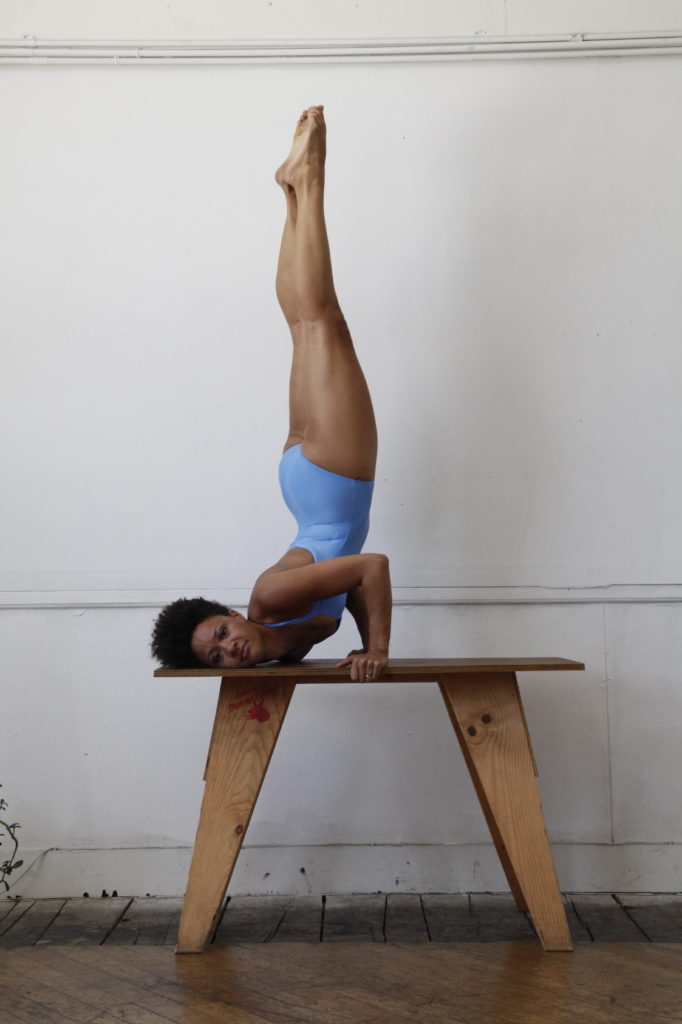
I’ve had a shift in relationship to the idea of “easier” in bisexuality. Because sure, there’s the element you’re talking about, of you can sort of disappear into hetero-land if you want. But I don’t know if that’s actually true, because anytime I’ve tried to do that are the times I’m most profoundly unhappy because I’m not just being who I am. Then I’m met with, “Of course you’re just a nice straight girl.” Because that’s what you’re doing. But no, it’s not who I am! I feel like that part of myself is being suffocated and crushed.
I think there’s a “yes and.” If that’s a path that feels right to you, then great, but for myself it’s pressure rather than reality that might lead me to ever make those types of choices. I’m in a relationship now with a bi man and it’s the best relationship I’ve ever been in my life, and I couldn’t possibly imagine dating a straight guy ever again, quite frankly.
PIP: Is it because you can relate to each other in that way?
KH: We can relate to each other, the shift of gender expectations in our relationship is beautifully fluid, there’s no sense of being threatened by each other’s identity on either side. I feel embraced and loved for who I am, not in spite of who I am. It’s pretty great.
PIP: In closing, why is bi visibility so important to you?
KH: I think it’s the other side of the coin of what we were just talking about. It’s an opportunity for people who do feel very isolated, and I think there are a lot of them, to be able to look up and go, “Oh, this feeling I’m feeling, this struggle I’m going through, I’m not actually alone, this person over there is like me.” I think that’s a really important thing.
Also I know for a lot of bi people there’s this challenge of, “Well, if I don’t feel 50/50, if I’m not equally attracted to a variety of people, I’m not actually bi.” They might feel ostracized by this lovely community that exists. It’s important for me to make sure that these people know there’s space for them and we’re here and they belong here as well.
Keep up with Kai on Instagram @kaihazelwood and The Good Trouble Makers @goodtroublemakers. If you’re in the LA area, buy your ticket to Unicorn pARTy here!
